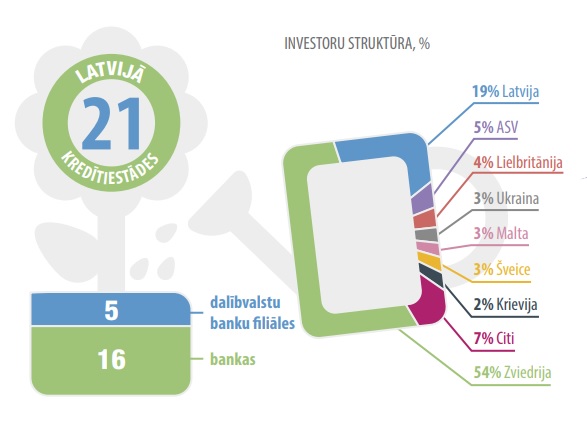The data cover 2017 so do not include subsequent developments such as the speedy collapse of ABLV bank - one of the country's largest - and an ongoing effort to reduce the non-resident banking sector at breakneck speed.
The reduction was "mainly due to the narrowing of business volume related to foreign customer service, also affecting profit figures... At the end of the year, the share of domestic customers in banking sector deposits was 60%," FKTK said.
Due to the decrease in foreign deposits, total deposits in banks in 2017 decreased by EUR 1.1 billion or 5.1%.
Deposits by foreign customers fell 12% year-on-year, reaching €8.1bn at the end of the year, in advance of the ABLV crash. Meanwhile, an increase in domestic households' deposits of 479 million euro was almost offset by a decrease in deposits of government and financial institutions so the total amount of domestic customer deposits remained virtually unchanged at EUR 12.2 billion.
The profitability of the banking sector continued to decline for a second year. In total, the banking sector operated at a profit of EUR 236.1 million, which is almost half that of the previous year, when the banks' profit amounted to EUR 454.4 million. Although profit margins in 2016 were influenced by one-off revenue from the sale of Visa Europe shares, excluding this effect, the profit of the banking sector in 2017 was still 29.5% lower than in the previous year.
The regulator was also at pains to point out that liquidity remained high in 2017. Despite the decline in deposits, the liquidity ratio of the Latvian banking sector remains at a high level, reaching 59.9% at the end of December 2017, twice the minimum liquidity requirement requirement of 30%.
The banks remain unwilling to open their purse strings to borrowers. New lending volume was lower than in the previous year. In 2017, domestic customers received new loans worth EUR 2.3 billion, a decrease of 23.6% compared to the previous year.
Similarly, across the sector, Return on Equity (ROE) fell to 7.6% from 14.3% in 2016.
The data were released on the same day the Ministry of Finance said it had drafted amendments to the Law on the Prevention of Money Laundering and Terrorist Financing to restrict high-risk client financial operations in the Latvian financial sector.






























